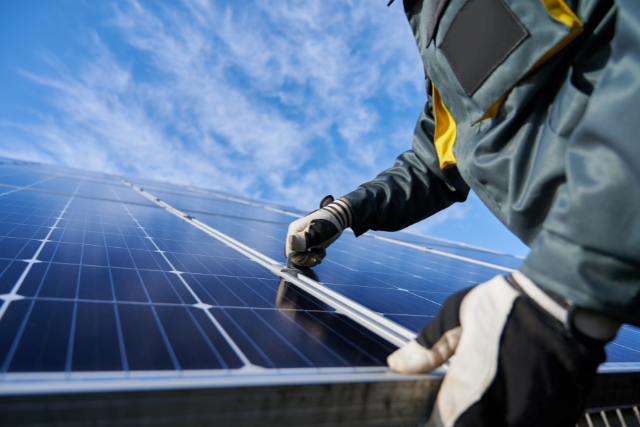What Is Solar PV?
Solar PV has gained immense popularity as a clean and reliable energy source that holds the promise of reducing greenhouse gas emissions and minimising our dependence on fossil fuels. Photovoltaics (PV) has transformed the way we produce and consume electricity.
Solar PV, short for Solar Photovoltaic, is a technology that converts sunlight directly into electricity using semiconductor materials. This process is based on the photovoltaic effect, where certain materials have the ability to generate an electric current when exposed to light.
Solar PV technology is often referred to as “solar panels,” as these panels are the most visible components of a solar PV system. These panels are installed on rooftops, fields, or any other suitable location where they can capture sunlight.

What Is Photovoltaics?
Photovoltaic (PV) is the process through which solar PV technology converts sunlight into electricity. The term “photovoltaic” originates from the words “photo” meaning light and “voltaic” referring to electricity.
In a solar PV cell, the photovoltaic effect occurs when photons (particles of light) strike the surface of the semiconductor material within the cell. This interaction causes electrons to be released from the atoms, creating an electric current.
By connecting multiple solar cells in series and parallel, solar PV panels are constructed, which can generate enough electricity to power homes, businesses, and even entire communities.
How Does Solar PV work?
Solar PV panels consist of several solar cells connected in series and parallel configurations to create modules with varying power outputs.
The most common material used in solar cells is crystalline silicon, though thin-film solar cells made of different semiconductor materials have also gained popularity due to their lower manufacturing costs and flexibility.

What Is A Solar PV System?
A solar PV system is a complete setup that includes solar panels, mounting structures, electrical components, and sometimes energy storage systems. The primary purpose of a solar PV system is to generate electricity from sunlight, which can be used to power residential, commercial, and industrial establishments.
A typical solar pv system includes the following components:
Solar Panels: Solar panels are the heart of the system. They absorb sunlight and convert it into direct current (DC) electricity.
Mounting Structures: These are used to securely fix solar panels at an optimum angle and orientation to maximise sunlight exposure.
Inverter: The DC electricity generated by solar panels is converted into alternating current (AC) electricity by an inverter. AC electricity is the standard form of electricity used in homes and businesses.
Electrical Wiring: Wiring connects the solar panels, inverter, and other electrical components, ensuring the flow of electricity within the system.
Energy Storage (optional): In some cases, systems are equipped with solar pv battery storage or other energy storage solutions to store excess electricity generated during sunny days for use during periods of low sunlight or at night.
Metering and Monitoring: Metering systems allow users to measure the electricity generated by the solar PV system, while monitoring systems provide real-time data on the system’s performance.
Advantages Of Solar PV Systems
Renewable Energy: Solar energy is a renewable resource, ensuring a long-term and sustainable energy supply.
Environmentally Friendly: Solar PV systems produce electricity without emitting greenhouse gases, helping to mitigate climate change and reduce air pollution.
Low Operating Costs: Once installed, solar PV systems have relatively low operating and maintenance costs, making them financially attractive in the long run.
Off-Grid Solutions: In remote areas with limited access to the grid, solar PV systems can provide electricity independently, improving energy access.

How Long Do Solar Panels Last?
The standard for most solar panels is 25 – 30 years.
Apply For A Solar PV Grant
Apply for a solar pv grant today by filling out our quick eligibility form below. Once you have filled out the form, a member of our team will be in touch with you to discuss the next steps.

